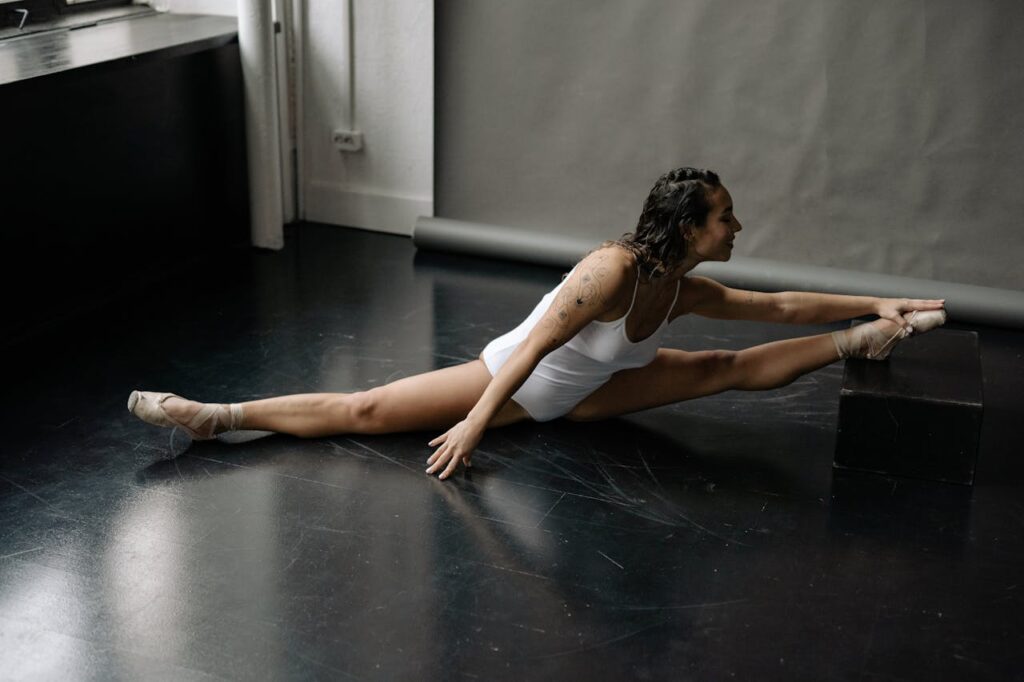Learning how to do the splits is one of the most rewarding flexibility goals you can achieve. Whether you’re inspired by dancers, gymnasts, or simply want to improve your overall mobility, mastering the splits requires dedication, proper technique, and a progressive approach. This comprehensive guide will walk you through everything you need to know to safely achieve front splits, side splits, and even middle splits, regardless of your current flexibility level.
Understanding the Anatomy of Splits
Before diving into the techniques, it’s crucial to understand which muscle groups you’ll be working with. The splits primarily target your hamstrings, hip flexors, glutes, quadriceps, and the muscles around your hips. Your hamstrings run along the back of your thighs and need to lengthen significantly for front splits, while your hip flexors at the front of your hips must open for proper split positioning.
Think of your muscles like rubber bands – they need to be warmed up and gradually stretched to avoid snapping. This is why rushing into splits without proper preparation often leads to injury and setbacks.
Safety First: Essential Precautions Before You Begin
Words of Caution When Learning Splits
Your safety should always be the top priority when working toward splits. Here are the essential safety guidelines:
- Never force a stretch – Pain is your body’s warning signal
- Always warm up thoroughly before attempting deep stretches
- Listen to your body and respect your current limitations
- Stay hydrated as dehydration can make muscles more prone to injury
- Consider your age and physical condition – older adults may need longer progression times
When to Seek Professional Help
If you experience sharp pain, persistent soreness lasting more than 48 hours, or any joint discomfort, consult a physical therapist or qualified fitness professional. They can assess your individual needs and provide personalized modifications.
The Complete Guide to Different Types of Splits
Front Splits (Sagittal Splits)
Front splits involve extending one leg forward and one leg back, creating a straight line. This is often the easiest type for beginners because it follows natural walking patterns.
Side Splits (Lateral Splits)
Side splits require both legs to extend out to the sides, creating a wide V-shape. This variation demands significant hip flexibility and adductor muscle length.
Middle Splits (Straddle Splits)
Often overlooked in basic guides, middle splits involve sitting with both legs extended wide to the sides. This variation is excellent for improving overall hip mobility and is particularly beneficial for dancers and martial artists.
Your Progressive 30-Day Splits Training Program
Week 1: Foundation Building (Days 1-7)
Daily Commitment: 15-20 minutes
Start with these fundamental stretches that you’ll perform every day:
Essential Daily Stretches (Hold each for 30-60 seconds per side)
- Forward Fold with Clasped Hands
- Stand with feet hip-width apart
- Clasp hands behind your back
- Fold forward, letting arms fall over your head
- Focus on lengthening the spine
- Low Lunge (Runner’s Lunge)
- Step right foot forward into a lunge
- Lower left knee to the ground
- Keep front knee over ankle
- Feel the stretch in your left hip flexor
- Seated Forward Fold
- Sit with legs extended straight
- Reach forward toward your toes
- Keep spine long, avoid rounding
- Butterfly Stretch (Cobbler’s Pose)
- Sit with soles of feet together
- Gently pull heels toward your body
- Fold forward with a straight spine
- Figure-4 Hip Stretch
- Lie on your back
- Cross right ankle over left knee
- Pull left thigh toward chest
Week 2: Deepening the Practice (Days 8-14)
Continue with your foundation stretches and add these intermediate movements:
Progressive Additions
- Pigeon Pose
- From hands and knees, bring right knee forward
- Extend left leg straight back
- Square hips and fold forward
- Standing Forward Fold with Wide Legs
- Stand with feet 3-4 feet apart
- Fold forward, walking hands toward the ground
- Lizard Pose
- From low lunge, place both hands inside front foot
- Lower to forearms if possible
Week 3: Advanced Preparation (Days 15-21)
Building Toward Full Splits
- Half Split (Ardha Hanumanasana)
- From low lunge, straighten front leg
- Sit back over rear heel
- Fold forward over straight leg
- Supported Split Practice
- Use yoga blocks or pillows under your hips
- Gradually lower into split position
- Hold for 1-2 minutes
Week 4: Integration and Mastery (Days 22-30)
Final Progression Stretches
- Wall-Assisted Splits
- Lie on your back near a wall
- Extend one leg up the wall, other on floor
- Gradually scoot closer to wall
- Active Split Preparation
- Practice lifting legs in split position
- Engage core and leg muscles
- Build strength alongside flexibility
Step-by-Step Instructions for Achieving Your First Split
The 6-Step Method to Front Splits
Step 1: Warm-Up Sequence (5 minutes)
- Light cardio (marching in place, arm circles)
- Dynamic leg swings
- Hip circles
Step 2: Foundation Stretches (10 minutes)
- Perform your daily essential stretches
- Focus on breath and relaxation
Step 3: Progressive Deepening (10 minutes)
- Move into half-split position
- Use props for support
- Breathe deeply, holding 3-7 breaths
Step 4: Supported Split Attempt (5 minutes)
- Lower into split with blocks or pillows
- Only go as far as comfortable
- Focus on alignment over depth
Step 5: Active Engagement (3 minutes)
- Engage leg muscles in split position
- Lift slightly, then relax deeper
Step 6: Cool-Down and Integration (2 minutes)
- Gentle counter-stretches
- Child’s pose or gentle twists
Breathing Techniques for Deeper Stretches
Proper breathing is crucial for achieving deeper stretches safely. Use these techniques:
- 4-7-8 Breathing: Inhale for 4 counts, hold for 7, exhale for 8
- Progressive Relaxation: With each exhale, allow muscles to release slightly
- Mindful Breathing: Focus on breath to distract from discomfort
Common Problems and Troubleshooting
Plateau Breakthrough Strategies
If you’ve hit a plateau in your progress:
- Vary your routine – Try different stretch sequences
- Increase frequency – Add short 5-minute sessions
- Focus on strength – Build supporting muscle strength
- Check your nutrition – Ensure adequate protein and hydration
Age-Related Considerations
For Adults Over 40:
- Allow longer warm-up periods (10-15 minutes)
- Extend progression timeline to 6-8 weeks
- Focus more on consistency than intensity
- Consider morning stretching when muscles are naturally tighter
For Teenagers and Young Adults:
- Can progress more quickly (2-4 weeks possible)
- Still emphasize proper form over speed
- Be aware of growth spurts affecting flexibility
The Science Behind Flexibility Training
Recovery Time Between Sessions
Your muscles need time to adapt and recover. Here’s the optimal schedule:
- Daily light stretching: 10-15 minutes of gentle mobility
- Intensive sessions: Every other day for deep stretching
- Rest days: Include at least one complete rest day per week
Nutrition and Hydration Impact
Your flexibility training is significantly affected by:
- Hydration levels: Dehydrated muscles are less pliable
- Protein intake: Supports muscle recovery and adaptation
- Anti-inflammatory foods: Reduce muscle soreness
- Timing: Avoid deep stretching immediately after large meals
Complementary Exercises for Better Splits
Strength Training for Flexibility
Building strength in your stretched position helps maintain and improve flexibility:
- Isometric holds: Hold split position while engaging muscles
- Leg lifts: Strengthen hip flexors and hamstrings
- Core work: Supports proper alignment in splits
- Glute bridges: Strengthen posterior chain
Modifications and Props for Every Level
Using Props Effectively
- Yoga blocks: Support hips in seated stretches
- Straps: Assist in reaching feet during stretches
- Pillows: Cushion knees and provide support
- Wall: Use for supported stretches and alignment
Modifications for Limited Mobility
If you have physical limitations:
- Focus on range of motion improvements rather than full splits
- Use chair-supported stretches
- Emphasize gentle, consistent movement
- Consult healthcare providers for personalized modifications
Creating Your Personal Splits Journey
Setting Realistic Goals
- Week 1-2: Improved flexibility and comfort in basic stretches
- Week 3-4: Noticeable progress toward split position
- Month 2-3: Achieving supported splits with props
- Month 3-6: Working toward unsupported splits
Tracking Your Progress
Keep a flexibility journal noting:
- Daily stretch duration
- Comfort level (1-10 scale)
- Specific improvements
- Any discomfort or concerns
Frequently Asked Questions
How long does it take to learn the splits?
Most people can achieve significant progress in 4-8 weeks with consistent daily practice. However, achieving full splits may take 3-6 months depending on your starting flexibility, age, and dedication to practice.
Can anyone learn to do the splits?
While most people can significantly improve their flexibility, individual anatomy varies. Some people may have bone structure limitations that prevent full splits, but everyone can benefit from increased flexibility and mobility.
Is it normal to feel sore after stretching?
Mild muscle soreness 24-48 hours after stretching is normal, especially when starting. However, sharp pain during stretching or severe soreness indicates you may be pushing too hard.
Should I stretch every day?
Yes, gentle daily stretching is beneficial and necessary for splits training. However, intense deep stretching should be limited to every other day to allow for muscle recovery.
What’s the difference between active and passive flexibility?
Passive flexibility is your range of motion when relaxed (like in a supported split), while active flexibility is your range when using your own muscle strength. Both are important for safe, functional splits.
Your Next Steps to Splits Success
Achieving the splits is a journey that requires patience, consistency, and proper technique. Remember that everyone progresses at their own pace, and comparing yourself to others can lead to frustration and injury.
Start with the foundation stretches outlined in Week 1, and gradually progress through the program. Listen to your body, celebrate small improvements, and maintain a positive mindset throughout your flexibility journey.
Ready to begin? Set aside 15-20 minutes today for your first session, and commit to showing up for yourself every day. Your future flexible self will thank you for starting this incredible journey toward achieving the splits.
Remember: consistency beats intensity every time. Small daily efforts compound into remarkable results over time. Begin today, stay patient, and trust the process – your splits are waiting for you!



